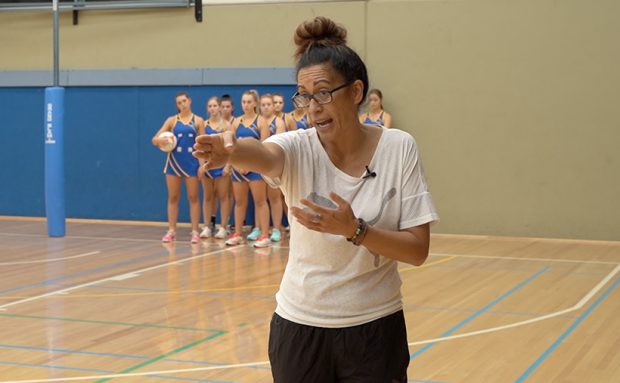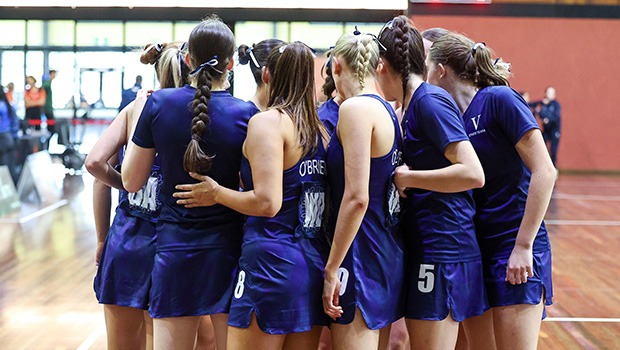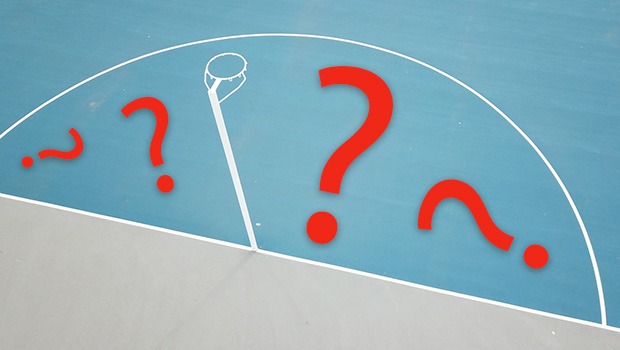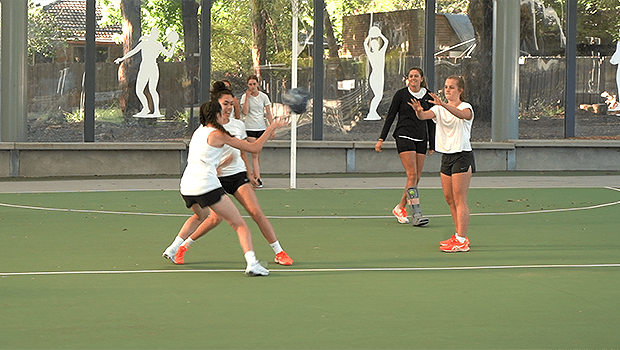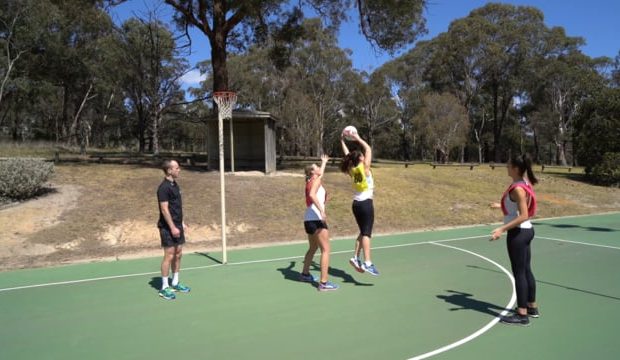Preferred starting sevens – are they a thing of the past, or are they the key to getting back to the top for our Aussie Diamonds? Former Australian Heath Brown dives in with some questions and lessons you can take away for your own coaching…
It was more than 12 months ago when netball’s last major tournament, the Commonwealth Games, was fought out.
After the Aussie Diamonds home with a silver, many Australian fans had their hands up in the air, confused by a rather bewildering half-time rotation policy that had rarely been seen in Aussie coaching ranks at a high stakes tournament. It happened in most games all tournament, meaning the usually steel-like bonds that are formed in combinations over the course of the fortnight were more like Blu-Tac when it came to the final.
I think this posed the biggest question for the Diamonds before the World Cup: would we we see bibs flying throughout the tournament as Lisa Alexander and the Diamonds coaches try to make full team rotations a new winning formula? Or would they return to tradition and run-in a preferred seven with impact players coming off the bench as needed?
COACHING VIDEOS: JOIN NOW FOR 400 DRILLS!
The first phase of competition at the World Cup has given us some of these answers (in part), with upcoming games poised to reveal what formula the Aussie coaches will adopt as the big games approach.
Let’s explore the pros and cons of rotations, using the Diamonds as our example, and explore as netball coaches how we can think differently about building form coming into short tournaments or finals series.
Revolving doors
The Aussie 12 has already seen so much rotation at a squad level before the tournament, let alone the starting seven. We’ve all watched glamour girl Kim Ravaillon’s slow exit from the team, perhaps never to be seen again.
We’ve seen Kate Moloney star on debut and then be pipped at the post by in-form middies. We’ve seen Paige Hadley dumped after being a winner four years ago, only to be picked again on the eve of the World Cup.
We were confused when recent vice-captain Gabby Simpson was overlooked, despite the team lacking experience. Let’s face it – the revolving door of national selections has had more twists and turns than the lazy Susan at your favourite Asian restaurant. For me this gives more weight to the need for stability, and to find attacking and defensive combinations to run in with more court time. I think we are seeing some of this in the Diamonds selections already, acknowledging there are new combinations and using the tournament to really fuse the best of those combinations through more court time together.
What history tells us…
Looking back at our rich history of success at World Cups, all of those campaigns typically had a lean towards a preferred seven. It didn’t mean that seven played all game every game, it meant they were the combinations most likely to win the tournament and were put on the court with more minutes to refine and peak their combinations.
Lisa Alexander started her career known for playing her seven to the death. Even against lower-ranked teams and with with unassailable leads, she was an ice queen and continued to play her preferred crew to put those sides to a ruthless death and pump the tyres of her starting seven. She did this with her era-dominant Melbourne Phoenix and also started this way with the Diamonds.
That’s why the 2018 Comm Games was such a shock, as it was a departure from what we were used to. You have to applaud the bravery of innovating and testing another route to a gold medal with a full team rotation policy, but I think we learned that at an international tournament, which is short in length and high in stakes, it may not be the best environment to share the bibs around. Before Alexander’s time, Norma Plummer’s best success came from stable sevens, as did Jill McIntosh and those before her.
In my opinion, we should get back to the Aussie way and let history repeat itself (and not in the Commonwealth Games kinda way).
Change-ups
Having a preferred seven doesn’t mean a steadfast ‘no change’ policy. It simply means there are less of the half-time full team rotations we saw consistently pulled out for Australia at the Comm Games. Single changes to rest players and introduce impact players when a starting seven needs a change-up are commonplace, but making them tactical and not wholesale is key.
The Jenny Borlase injection in the 1999 final was a great example of this: find where the starting seven combination is most broken and plug it with the player who can change that up, but do that around players who already have strong connections. In Games 2 and 3 at the World Cup we have seen more of this approach – running tactical changes to test a different player in a unit that has played the full game. And for me, it’s producing our best netball. The Watson-Browne-Wood connection is looking ominous, regardless of whether C-Bass or Thwaites is under the post.
The old “expect mistakes” rule
I’m not sure it’s been statistically validated, but us coaches are normally told that the introduction of a new player mid-game will likely result in a higher likelihood of couple of errors, as opposed to keeping a player on who is already settled in.
Based on that theory, the maths is simple: the more players you bring in, the more mistakes you need to expect. Three changes multiplied by two mistakes is six goals missed, and six goals potentially gained by the opposition off our centre pass. Wholesale changes like this could bleed you of several goals and change a match in minutes. This is one of the reasons why it’s potentially such a high-risk coaching strategy to employ on the big stage.
Resisting the knee jerk
Knowing when to pull a change is also tough, as is knowing which player to pull out of the combo when it’s not working. By default we normally pick the player who coughed up possession, but is it really about the work being done in front of and around her?
I still have nightmares about seeing Laura Geitz on the bench late in the Comm Games final. She was kept quiet by Jo Harten for long patches, but it was the defensive midcourt who were letting the ball fly through with ease. I still say to this day that had Laura been on that court, the result would have been different. The last seconds saw a choke from Harten and those are the moments Geitz lives for. Instead, a young line-up gave away a match-winning missed rebound and then a penalty under the post to give the Roses three bites at a gold medal. Geitz was the right asset in that combo and I think should’ve been left on court. She wouldn’t have given them any second chances, let alone a third. The same could be said for Madi Robinson.
The point being: look beyond the mistake and the red-handed player, and think through the implications on the whole match of removing a certain type of player, and then make your decision. Noeline Taurua has been adopting this at the Silver Ferns. In one recent outing, the Aussies smashed the Ferns for a quarter and all of her charges were quiet. She resisted the knee jerk reaction as the commentators called for wholesale changes, instead making a small tweak, and then beat the Diamonds for three quarters. I heard her once say, “I’m more interested in how they bounce back from a challenge than benching them for the mistakes they made to start with”.
Infamous Aussie Rules coach Paul Roos adopted a similar style with his coaching, suggesting coaches who drag a player at the first sign of trouble are probably not going to win too many big matches. And already with the Ferns at the World Cup we are seeing more consistency, having previously being victims of wholesale rotation policies and flurries of squad ins and outs before Taurua arrived. Watson and Kopua are being run into lethal form with every passing minute they’re on court, while Langman will marshall the troops from centre – giving them way more firepower that they had at the Commonwealth Games.
Avoiding the emotional dilemmas
In any other country, the top 20 players from Australia would be starters. So picking a seven must be a huge coaching headache and heartache. Sticking to a seven for full games and managing the hearts and minds of the five on the bench would be even more gut-wrenching. But that’s part of what we are entrusted or paid to do as coaches: make the tough decisions to get the win and manage the humans within.
It’s not little league where many clubs now adopt a minimum quota of court time for players to make sure our growing athletes get a turn. As the stakes get higher and the longer these athletes go in the pathway, the best thing they need to learn is how to be a bench player and still contribute with everything they have.
Start best combos, not just best players
Everyone who has played our great game knows that when a team is at its best, there is an indescribable and uncoachable gel of styles between them and their combinations. Think Ellis and Harby, Geitz and Corletto, Southby and McMahon, Coxy and Green, the Von Bertouch sisters. Combinations beat individual champions, no matter how good they are.
It will be fascinating to see which combinations Lisa Alexander favours as the World Cup rolls on. Wood and Browne are locked in for me. No one came near them for two years in Suncorp Super Netball. The rest of the court has less obvious pre-existing combinations to draw on, but hopefully these have surfaced in the many training matches leading up to Liverpool.
The big challenges will come with C/WD combo in defence and GD/GK in the circle once we start taking on the pace of the top five sides. These combinations are either new, yet to prove they can win at a tournament like this as shutdown combinations, or got exposed at the Commonwealth Games. Will it be redemption or a repeat of last year, where the Diamonds are left without a winning defensive combination in a tough final?
At this stage, if I was to make a call on who I would be running, it would be C-Bass, Wood and Browne – no one could stop them for two years at Lightning and no one will here either. I want to see more of both Watson and Hadley in centre, as I think Paige has more defensive presence to offer. Defensively I would focus in on Bruce and Brandley.
Heath Brown is the former Australian Men’s team captain, and has coached at the elite level in both the women’s and men’s games.
